Is it possible to eat buckwheat with milk: what are the benefits and harms of such a combination?
Buckwheat is the leader among cereals in terms of iron content; its whole grains contain as much protein as meat. Milk is also a healthy product, rich in calcium and vitamins. But their combination causes controversy among those who monitor nutrition. In this article we will tell you in detail about the benefits and harms that buckwheat with milk can bring.
Beneficial properties of buckwheat with milk
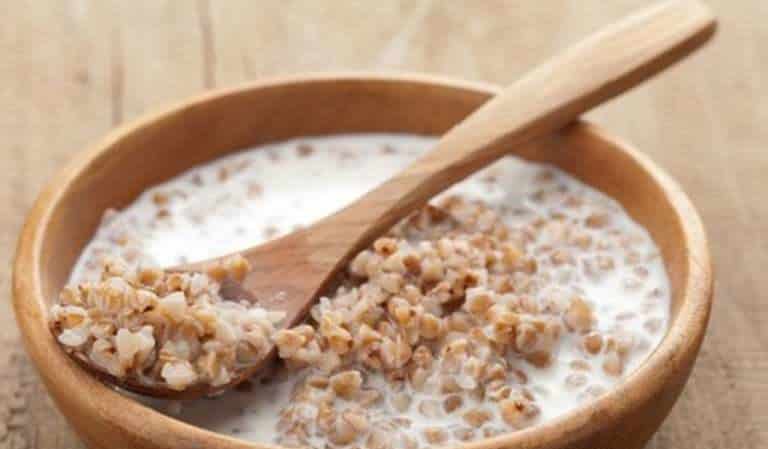
Milk buckwheat porridge is nutritious due to the high protein content in the cereal, a large amount of vitamins and minerals. Both ingredients do not lose their beneficial properties during heat treatment. Warm milk better reveals the taste and aroma of buckwheat.
Buckwheat porridge contains the following beneficial substances:
- polyunsaturated fatty acids omega-3 and omega-6 promote the absorption of proteins and fats, reduce cholesterol levels and the risk of cardiovascular diseases;
- flavonoids, which have anti-inflammatory properties, reduce the fragility of blood vessels and, being antioxidants, protect cells from free radicals;
- iron reduces fatigue;
- phosphorus prevents bone diseases;
- B vitamins have a positive effect on the functioning of the brain and nervous system.
Buckwheat is a hypoallergenic product, so it can be eaten by people prone to allergies. In combination with milk, it helps remove toxins from the body during poisoning and radiation.Porridge helps restore liver cells, so it is included in the diet of patients in medical rehabilitation centers.
Buckwheat with milk is given to children from 8 months, as the risk of allergies is minimal, and vitamins and minerals are easily absorbed. Athletes regularly eat this porridge to strengthen muscles and blood vessels, as well as to increase the body's endurance. Elderly people benefit from milk porridge to normalize blood pressure and cholesterol levels, and protect blood vessels from blockage.
Calorie content, BJU and glycemic index of buckwheat with milk
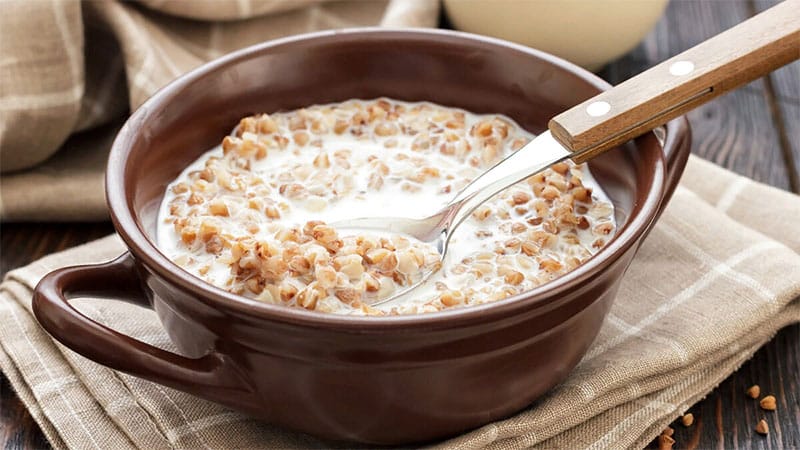
Buckwheat porridge contains slow carbohydrates, which means it saturates the body with energy for a long time. And the high protein content gives muscle tone.
Content of proteins, fats and carbohydrates (BJU) in buckwheat with milk per 100 g of dish:
- proteins - 6.7 g;
- fats - 2.2 g;
- carbohydrates - 27.7 g.
Calorie content of 100 g of porridge is 151.6 kcal.
Milk buckwheat porridge is often prepared with the addition of other ingredients. The table shows calorie content and dietary fat per 100 g, taking into account added products.
| Type of dish | Calorie content, kcal | BZHU, g |
|---|---|---|
| With sugar | 92,05 | 2,97 / 3,35 / 12,58 |
| With milk without sugar and butter | 74,57 | 3,14 / 3,54 / 7,6 |
| With butter | 110,97 | 3 / 7,81 / 7,23 |
| With honey | 87,02 | 3,03 / 3,37 / 11,21 |
| With sugar and butter | 125,69 | 2,58 / 7,41 / 11,97 |
The glycemic index (GI) of a product is important to know for those who monitor their blood sugar levels or want to eat food that fills them for a long time. The index shows how quickly carbohydrates in a dish are converted into sugar.
The GI of boiled buckwheat with milk is 33 units. This is a low indicator, which indicates that carbohydrates are slowly absorbed in the body and evenly saturate the blood with sugar. This does not overload the pancreas. The energy released is not converted into fat and lasts for several hours.
The GI of buckwheat with milk varies depending on the ingredients added to the porridge.For example, when sugar is added, the indicator increases: blood sugar levels rise quickly and a large amount of energy is released. If this energy is not used up, it is converted into fat.
Is the dish effective for weight loss?
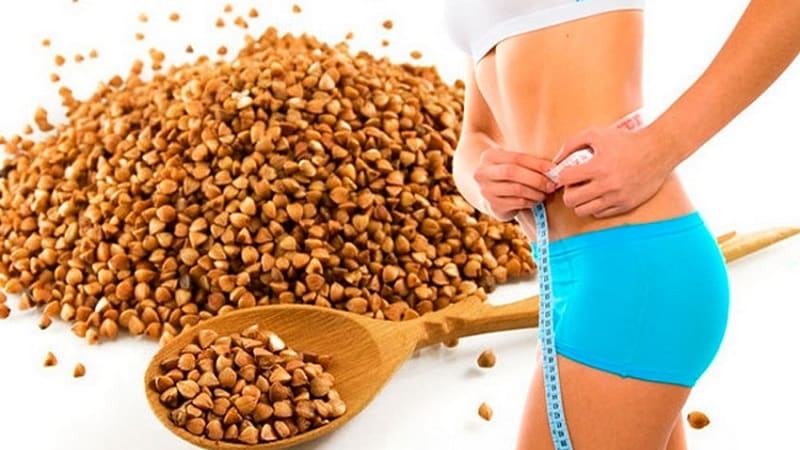
If you want to lose excess weight, monitor the glycemic index, which should be up to 55 units. Therefore, buckwheat with milk is included to the diet menu. A small portion of such porridge saturates the body for a long time, and the high content of vitamins and minerals in the dish heals the body.
Attention! It is recommended to choose whole grain cereals rather than crushed ones. Prepare the porridge without sugar, and after cooking add a little honey.
Is it possible to eat buckwheat with milk and why not?
It is recommended to include milk buckwheat porridge in the menu 2-3 times a week. It can be eaten for breakfast and dinner. In the morning it will give a boost of energy and saturate the body with vitamins for a long time. And in the evening it will relieve the feeling of heaviness and help you fall asleep.
Reference. Buckwheat contains large amounts of the bioflavonoid rutin, which helps treat depression.
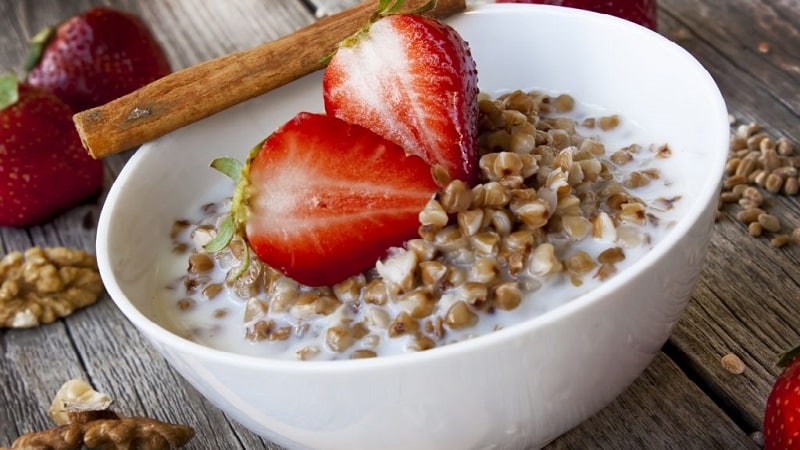
During pregnancy and pregnancy
It is useful for pregnant and lactating women to eat buckwheat with milk due to the high content of vitamins and minerals, fiber and low GI. Zinc in the porridge improves the functioning of the ovaries, supports sexual activity and helps to avoid hormonal imbalance.
The beneficial substances in these products are involved in the development of the endometrium, to which the fertilized egg is attached.
For diabetes
It is important for people with diabetes to monitor the GI of all foods they eat. If it is above 70 units, these products are excluded from the diet.
Buckwheat porridge with milk is not contraindicated for diabetics, and even, on the contrary, is useful due to the slow absorption of carbohydrates and a gradual increase in blood sugar. This is facilitated by fiber and amino acids in the dish.
For gastrointestinal diseases

Buckwheat with milk is useful for gastrointestinal diseases: pancreatitis, diseases of the stomach and duodenum beyond the acute stage. Porridge weakens the symptoms of diseases, promotes wound healing, coats the mucous membranes of the digestive organs, and helps the body recover faster from illness.
For constipation
Buckwheat has a mild laxative effect, so it helps with constipation. It also protects the mucous membranes of the intestinal organs and reduces the symptoms of irritation of the digestive organs. However, for constipation, buckwheat is cooked in water, since milk has the opposite effect.
Recipes for cooking buckwheat with milk
There are many options for preparing buckwheat porridge. It is boiled, steamed in a thermos and baked in the oven. We offer several recipes for this delicious porridge.
Buckwheat porridge cooked in water and milk
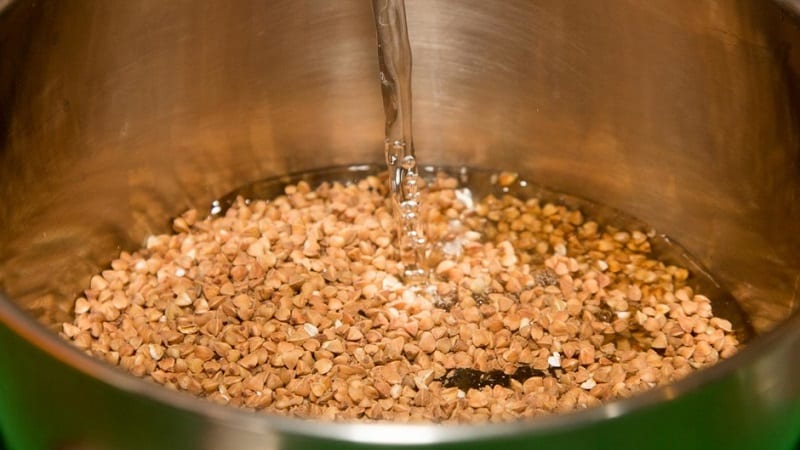
This is a classic recipe for buckwheat milk porridge.
Ingredients:
- 1 glass of buckwheat;
- 1.5 glasses of cold water;
- 0.5 glasses of milk;
- 0.5 tsp. salt.
Preparation:
- Rinse the cereal with running water, pour into a saucepan, add water and milk, cover with a lid and put on high heat.
- Bring the porridge to a boil, add salt and stir. Cover with a lid, leaving a small gap.
- Cook over low heat until the water evaporates from the surface.
- Cover the porridge completely with a lid and cook for another 10 minutes.
- If desired, add butter, sugar or honey to the finished porridge.
Buckwheat porridge steamed in a thermos

The most useful option for preparing buckwheat, because minimal heat treatment of cereals and milk is carried out.
Ingredients:
- 1 glass of buckwheat;
- 1.5 cups boiling water;
- 2 glasses of milk;
- a pinch of salt.
Preparation:
- Preheat the thermos with boiling water, add cereal, pour boiling water over it, add salt.
- Close the lid tightly and shake the thermos vigorously to mix everything.
- Leave to steam at room temperature for 1.5-2 hours.
- Place the finished porridge in a convenient container and pour in warm milk.
What could be the harm of buckwheat with milk?
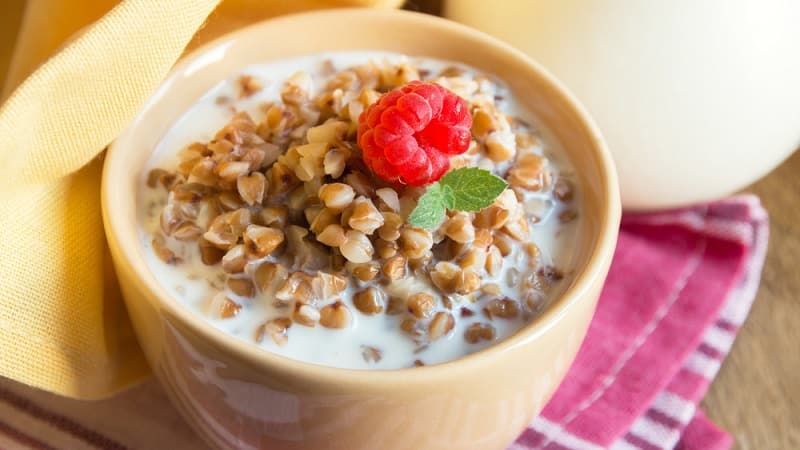
Despite many positive properties, this porridge can be harmful, therefore it has a number of restrictions for consumption:
- Buckwheat contains iron, and milk contains a lot of calcium. Together, these two substances are not fully absorbed by the body. Therefore, such porridge is eaten at normal hemoglobin levels.
- To digest buckwheat and milk, different enzymes are needed. The load on the digestive organs increases.
- Due to the enveloping properties of porridge, the absorption capacity of the digestive organs is reduced.
- For metabolic and hormonal disorders, endocrinologists recommend eating this porridge infrequently, a maximum of once a week.
- The beneficial properties of milk decrease when heated and boiled, so it is recommended to add it to boiled cereals.
Contraindications for use
You should avoid buckwheat with milk if you have the following diseases:
- lactose intolerance, in which dairy products should not be consumed;
- hemochromatosis, in which iron is not absorbed by the gastrointestinal tract, but accumulates in the muscles and bones;
- allergy to buckwheat;
- severe urolithiasis;
- stomach ulcer and gastritis in the acute stage.
This is interesting:
How does buckwheat affect stool: does it strengthen or weaken?
How to take buckwheat with kefir in the morning if you have diabetes
Conclusion
Buckwheat with milk can be consumed at any age. Porridge not only saturates the body for a long time, but also helps to lose extra pounds. However, it is important to consider possible side effects and eat buckwheat porridge without exceeding the recommended amount.